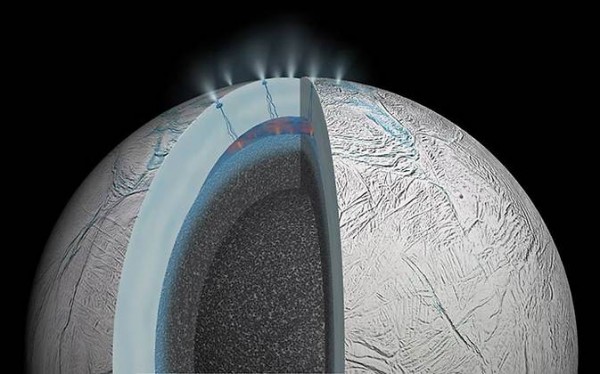NASA Probe Discovers Hot Springs Under Saturn Moon's Icy Surface
| Ana Verayo | | Mar 12, 2015 07:23 AM EDT |
(Photo : NASA/JPL) This cutaway view of Saturn's moon Enceladus is an artist's rendering that depicts possible hydrothermal activity that may be taking place on and under the seafloor of the moon's subsurface ocean.
Scientists believe there are hot springs bubbling underneath the icy surface of Saturn's moon, Enceladus.
If scientists prove this, this discovery will make Enceladus the only known body in the solar system apart from our planet where hot water and rock activity are present underground.
Like Us on Facebook
Evidence of this activity can make Enceladus another habitable place in our solar system where scientists can hunt for microbial life. On Earth, scientists have already identified unique life forms dwelling in hydrothermal vents found in ocean floors where there is no sunlight.
The data comes from NASA's Cassini probe whose mission is to explore Saturn and its natural satellites. Recently, the spacecraft detected a vast ocean beneath Enceladus. It also discovered giant plumes of gas and ice streaming out of the cracks located on the moon's southern polar region.
This latest study was led by Sean Hsu from the University of Colorado, Boulder and Yasuhito Sekine from the University of Tokyo and Takazo Shibuya from the Japan Agency for Marine-Earth Science and Technology.
With data gathered from spacecraft observations and computer simulations, researchers now have a clearer idea of how the plumes on the moon are linked to the lunar sea floor.
The team found out that the plumes are a result of water interaction with the rocks on the ocean floor. This results in mineral rich water that shoots upward, piercing the icy crust, and erupting into space with gases and ice. These plumes also contribute to Saturn's biggest ring.
New data also suggest the ocean is apparently deeper than previous estimates, which is more than 50 kilometers below the icy crust. The Cassini team also believes the ocean can even be bigger than North America's Lake Superior.
These findings were published in the journal Nature.
TagsNASA Probe Discovers Hot Springs Under Saturn Moon's Icy Surface, NASA, NASA Cassini probe, cassini spacecraft, Saturn, saturn moon enceladus, hot springs NASA probe saturn moon
©2015 Chinatopix All rights reserved. Do not reproduce without permission
EDITOR'S PICKS
-

Did the Trump administration just announce plans for a trade war with ‘hostile’ China and Russia?
-

US Senate passes Taiwan travel bill slammed by China
-

As Yan Sihong’s family grieves, here are other Chinese students who went missing abroad. Some have never been found
-

Beijing blasts Western critics who ‘smear China’ with the term sharp power
-

China Envoy Seeks to Defuse Tensions With U.S. as a Trade War Brews
-

Singapore's Deputy PM Provides Bitcoin Vote of Confidence Amid China's Blanket Bans
-

China warns investors over risks in overseas virtual currency trading
-

Chinese government most trustworthy: survey
-

Kashima Antlers On Course For Back-To-Back Titles
MOST POPULAR
LATEST NEWS
Zhou Yongkang: China's Former Security Chief Sentenced to Life in Prison

China's former Chief of the Ministry of Public Security, Zhou Yongkang, has been given a life sentence after he was found guilty of abusing his office, bribery and deliberately ... Full Article
TRENDING STORY

China Pork Prices Expected to Stabilize As The Supplies Recover

Elephone P9000 Smartphone is now on Sale on Amazon India

There's a Big Chance Cliffhangers Won't Still Be Resolved When Grey's Anatomy Season 13 Returns

Supreme Court Ruled on Samsung vs Apple Dispute for Patent Infringement

Microsoft Surface Pro 5 Rumors and Release Date: What is the Latest?










